Caveat emptor should be the creed of the American silver collector, who, as a fledgling in his quest for the fine and rare, is apt to prove easy prey for the faker. It is in the spirit of service that the following hints are offered to the would-be collector with the hope that he may spare his purse as well as defend the honor of American craftsmanship in the precious metal.
In buying silver the following points should be carefully considered: (1) source, (2) style, (3) workmanship, and (4) marks. The first of these, while bearing least weight in the final analysis, is worthy of consideration. It is most comforting to acquire a piece that has descended in proper custody or one that has been vetted by a reputable dealer, but even these considerations should not dull the would-be purchaser’s sense with regard to the other requirements for vetting.
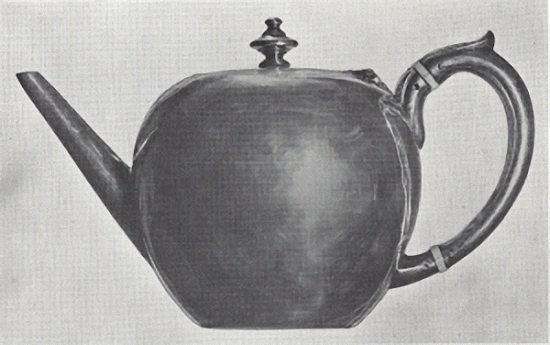
The importance of style cannot be overemphasized, for it is as art historian and artist that the faker tends to fail most conspicuously. Fortunately sufficient silver bas survived to enable us to trace with a fair degree of accuracy the evolution of design and decoration.
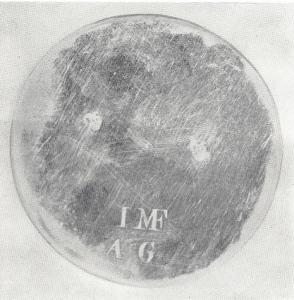
With such knowledge it is fairly easy to date a piece within ten years of its making. One having such knowledge would be wary of the teapot illustrated here (Plates 131 and 132), of a type prevalent in Europe about 1750, which bears a crude attempt at the stamp of the Bostonian, John Coney, who died in 1722.
For information on the evolution of forms in American silver, one should consult C. Louise A very’ s excellent catalogue of the Clearwater Collection (Metropolitan Museum of Art) as well as her treatise on style in Early American Silver. E. Alfred Jones’s Old Silver of Europe and America and the author’s American Silver might also be consulted.
Closely related to style and more subtle than the silversmith’s mark is the criterion of workmanship, which can be measured only after an exhaustive study of the known work of a given man. For the artists in metal, just as the artists in other media, have their definite peculiarities which proclaim the man.
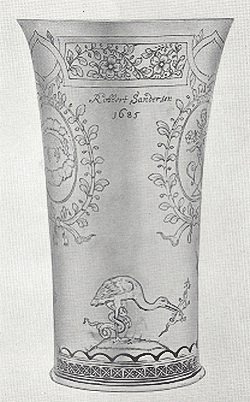
These may be found either in the hammerwork, moldings, method of soldering, or peculiar use of some form of decoration which runs through their work either in plastic decoration or engraved design.
An example of this is seen in the famous Sanders beaker by Vanderburch (Plate 133) and an old Dutch beaker bearing a spurious stamp, purporting to be the work of Cornelis Vanderburch of New York, who was known to have been working in the last two decades of the seventeenth century (Plate 134).
The small beaker bearing the contemporary date 1686 made its debut into the world of American silver in 1929 and was acclaimed by the connoisseurs as a fine example of this rare maker’s work, despite the fact that the pieces in company with it were rejected as obvious fakes. It was not until the acquisition of the Sanders beaker, dated 1685, for the Garvan Collection in 1932, that the fraud was discovered.
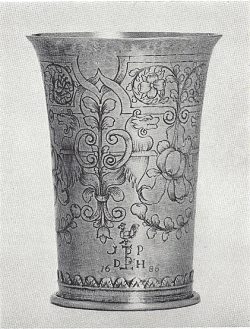
A careful comparison of the engraving and hammerwork prompted a searching study of the mark. If the buyer is within reach of a municipal museum fortunate enough to have a collection of silver, it would be well to compare the tentative acquisition with a known piece for the master’s touch.
I once saw a coffeepot of a type found only in Philadelphia and Baltimore c. 1790-1810, bearing a stamp REVERE for the famous Boston craftsman. It was engraved with a coat of arms of a style popular in 1765-80, which had been copied from a known book-plate engraved by Revere.
The poor quality of the engraving when compared with the Sander Beaker, caused intensive study.
There remains for consideration the silversmith’s mark, which should be noted most carefully. One may find a forged mark on a newly made piece of silver which is easy to detect from weight, the uniform scratches simulating wear, and the engraving.
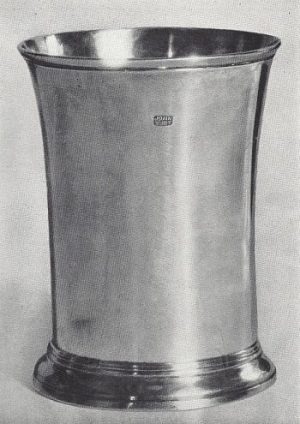
More difficult is the forged stamp on an old originally unmarked piece or an old mark cut from a spoon and carefully inserted in a larger and more valuable piece.
The latter is usually discernible under a strong glass, having a peculiar color around the inlay of the solder.
In the case of the former, one should be careful to note the surface surrounding the punch to ascertain whether or not it has been bruised, as is the case in the process of recent stamping, which once noted, is easily recognized. One should also be on the lookout for erased marks.
The beaker illustrated (Plates 135 and 136), of a style as yet not noted as American, bears on its side a spurious mark of John Burt and upon its base the bruises where the four English hallmarks had been erased.
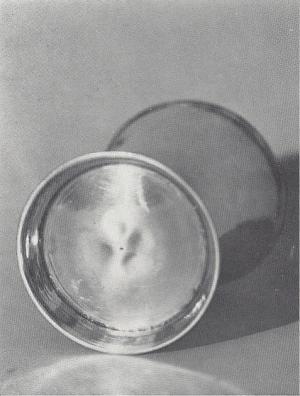
Again let me urge a comparison of the mark with known examples above suspicion in the collections of credited museums.
It was the wish of the late Francis P. Garvan, in giving the Mabel Brady Garvan Collection to Yale, to establish at Yale University a bureau of standards where a prospective buyer could submit his proposed purchase for comparison with the pieces in that great collection.
In closing let me urge you to give careful consideration to pieces by the following silversmiths whose forged marks have been frequently noted: Pygan Adams, Thauvet Besly, John Brevoort, Zacariah Brigden, Benjamin and John Burt, John Coney, William Cowell, John Dixwell, John Edwards, Daniel Henchman, Jacob Hurd, Knight Leverett, Myer Myers, John Noyes, Gerrit Onckelbag, Paul Revere, Joseph Richardson, George Ridout, Thomas Shields, Simeon Soumain, Philip Syng, Koenradt Ten Eyck, Andrew Tyler, Jacobus Van der Spiegel, Bancroft Woodcock and Benjamin Wynkoop.




